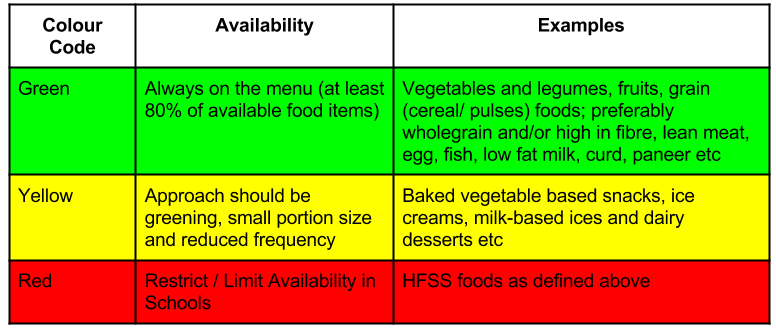[orc]Following the directions of the Delhi High Court in a PIL filed by Uday Foundation about the harmful effects of Junk foods in school children, the FSSAI has come up with draft guidelines to restrict/limit the availability of such foods in schools and nearby areas.
Following directions from the Delhi High Court in a writ petition filed by Uday Foundation, the Food Safety and Standards Authority of India (FSSAI) has now come up with draft guidelines for making available ‘Wholesome, Nutritious, Safe and Hygienic Food’ to School Children. This is the first step of the consultative process following which these draft guidelines would be converted to regulations. The guidelines have been divided into two parts, namely;
- Guidelines for making available Wholesome and Nutritious Food to school children
- Guidelines on Food Safety, Hygiene and Sanitation for Food available in school canteens
The Writ Petition in Delhi High Court
The writ petition was filed in 2010 by Uday Foundation, about the important issue relating to easy availability of junk food and carbonated drinks to children and the harmful effects they might have on children consuming them. The petition sought a ban on both junk food and carbonated drinks in schools and initiation of measures to develop a comprehensive school canteen policy with emphasis on health and nutrition.
The FSSAI under the Ministry of Health and Family Welfare filed an affidavit in the court stating the following,
- The term junk food had not been defined under the Prevention of Food Adulteration Act, 1954 and the subsequent rules. However the term junk food is understood as food that is high in fat, sodium and / or sugar and lacking in micro-nutrients such as vitamins, minerals, amino acids and fiber (HFSS).
- Such food is responsible for obesity, dental cavities, diabetes and heart diseases
- Efforts are being made by Ministry of Health and Family Welfare to make people aware of the harmful effects of increased consumption of junk food and to promote healthy eating habit
- FSSAI is also undertaking a project for development of Guidelines for making available quality and safe food in schools and had already initiated the process thereof.
The FSSAI submitted the draft guidelines to the court following which the court directed the FSSAI to convert these guidelines into regulation within a time frame. The FSSAI has thus put these draft guidelines in the public domain.
Summary of the Draft Guidelines
The draft guidelines lay down the following major points.
- They define a healthy lifestyle and the World Health Organization (WHO) global strategy on diet, physical activity and health.
- Identify foods, high in fat, salt and sugar (HFSS Foods) as harmful to children, commonly known as Junk food. The guidelines also identify the harmful effects and the diseases likely to result from high consumption of such foods.
- Restrict or limit the availability of most common HFSS foods in Schools and area within 50 meters.
- The guidelines list chips, fried foods, sugar sweetened carbonated beverages, sugar sweetened non-carbonated beverages, ready-to-eat noodles, pizzas, burgers, potato fries and confectionery items as most common HFSS foods.
- The guidelines also list samosa, chana bhatura etc as non-standardised deep fried foods also required to be regulated, though data on nutrient composition of such food.
- The guidelines also require formulation or development of a Canteen Policy, to provide nutritious, wholesome and healthy food in schools.
- Require setting up of a School Health Team.
- Require the schools to promote nutrition education and awareness though various tools such as posters.
- Provide for introduction of colour coding of foods in school canteens
- List sandwiches, fruit salad, fruits, paneer/vegetable cutlets, khandvi, poha, uthapam, upma, idlis and kathi rolls etc. as healthier menu options and low fat milk shakes with seasonal fruits, no added sugar, fresh fruit juice and smoothies with fruits, fresh lime soda, badam milk, lassi, jaljeera etc. as healthy beverage options.
- Provide for regulation of promotion of HFSS food among school children by Advertising Standards Council of India (ASCI) and other relevant bodies.
The guidelines also contain various other items such as listing the nutritional value, procurement, preparation, storage etc.
The Delhi High court had also directed CBSE to take a decision on whether these conditions be made part of the conditions for affiliation.
Featured Image: Abhisek Sarda | Flickr




